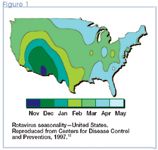Under the scope: Pentavalent rotavirus vaccine
Large-scale studies examine pentavalent rotavirus vaccine and its effects on one of the world's most prevalent infections.
Rotavirus gastroenteritis (RGE) is a leading cause of severe vomiting, diarrhea, and fever among infants worldwide. Currently, nearly every child in the United States becomes infected with rotavirus by 5 years old, and many are infected more than once.1 In the United States, one child in 15 requires intravenous fluids and one in 70 requires hospitalization because of RGE.2
Clinical characteristics

The immunologic mechanism by which rotavirus vaccines protect against RGE is unclear.9,10 However, neutralization antibodies to both G and P proteins appear to provide immunity, and seroconversion of immunoglobulin A antibodies seem to be reflective of protection.9,11 Although not fully understood, some data suggest that antibodies from an initial exposure to rotavirus are generally type specific, and children exposed only once to one serotype may still be at risk for infection from other serotypes.2,7,9 Broad-based immunity to rotavirus typically occurs only after multiple infections7 or perhaps multiple doses of vaccine.
Pentavalent and monovalent rotavirus vaccines
The pentavalent rotavirus vaccine (penta-RV, RotaTeq by Merck) is a human–bovine reassortant vaccine. Because rotavirus strains are species-specific, inclusion of bovine strains enhances the immune response to the virus but also appears to be attenuated enough to be virtually devoid of any vaccine-related adverse events.10,13 Penta-RV contains the four most prevalent circulating serotypes: G1, G2, G3, G4, as well as P1A[8], the attachment protein that combines with a number of other G types (eg, G9). This fully liquid vaccine, approved by the Food and Drug Administration (FDA) in February 2006, is the only rotavirus vaccine available in the US14 and is recommended by the American Academy of Pediatrics (AAP) and the Advisory Committee on Immunization Practice (ACIP).1,2
By contrast, the monovalent vaccine (mono-RV, Rotarix by GlaxoSmithKline) is derived from human rotavirus strains that have been attenuated using multiple passages through cell culture. The monovalent G1P1A[8] vaccine is currently under FDA review and is available in a number of countries outside of the US, including Europe and Latin America. The fairly remarkable efficacy results of studies of mono-RV conducted outside the US challenge the theory of serotype-specific immunity upon which penta-RV is based.15